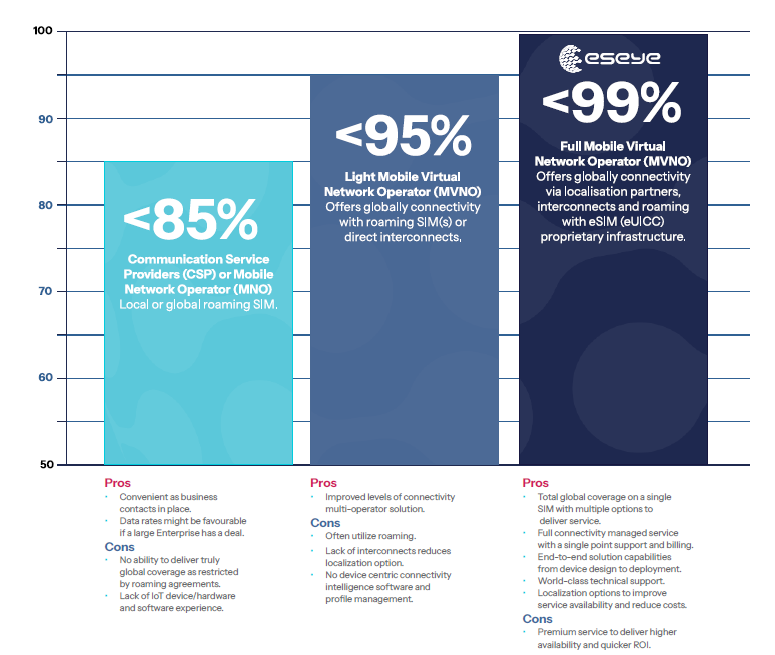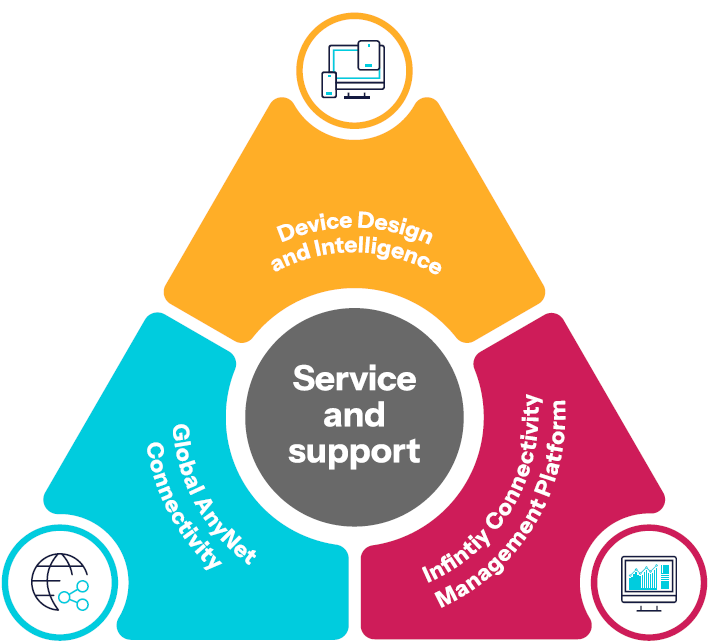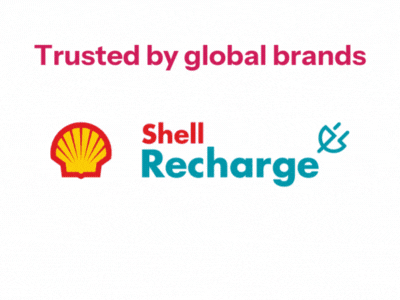
360° IoT Connectivity
Achieving the gold standard in cellular IoT connectivity
with total global coverage from a single eSIM.

Achieving the gold standard in cellular IoT connectivity
with total global coverage from a single eSIM.
Such is the importance of global connectivity to IoT success that every single percentage of service uptime matters. Among the businesses that contributed to Eseye’s latest State of IoT Adoption research, 78% said that achieving near 100% connectivity across their estate is crucial to their business case. However, only 1% are achieving 98% or higher; in fact, the majority are settling for far lower.
These businesses do not exist within a state of blissful ignorance; they are fully aware of the shortfall in quality. Yet despite this, 96% said they were satisfied with the service delivered by their connectivity provider.
Low expectations of connectivity levels are threatening IoT project success. High reliability and quality are not an unattainable goal, and consistent uptime of almost 100% is perfectly feasible. We know this because our customers achieve it daily. We’re steadfast in our commitment to deliver maximum uptime – anything less than 100% isn’t good enough in our eyes.
To prove our commitment to service quality, we sign strict service-level agreements to stand behind our promises.
In this paper, we explore how Eseye delivers ultra-high quality and reliable global cellular connectivity to millions of IoT devices around the world, every day.
High reliability and quality are not an unattainable goal, and consistent uptime of almost 100% is perfectly feasible."
If you have an existing connected device project but want a step change in connectivity performance that gets you incredibly close to 100% uptime, or you’re about to embark on a new smart connected device project, then this paper is for you.
High reliability and quality are not an unattainable goal, and consistent uptime of almost 100% is perfectly feasible.
Finding the focus
There are many reasons why IoT devices don’t connect properly or fall off the network. These are the factors that will stop you from reaching maximum availability. Some will be within your control, and others outside your control.
Getting as close to 100% as absolutely possible involves identifying the root causes of the gap and addressing those you can do something about.
This is often a case of making incremental improvements that build towards delivering the highest availability possible in three main areas: device design, network optimization, and the management of connectivity post-deployment.
The problems and solutions will be unique to your business case and objectives.
Ask yourself:
If you work with a connectivity provider, they should be able to support you in the aspects that come under your control and apply their expertise and capabilities to lift performance in those that don’t

…explore how Eseye delivers ultra-high quality and reliable global cellular connectivity to millions of IoT devices around the world…
Investing time and effort at the outset into optimizing the device design will ensure it does everything it needs to do to get – and stay – connected. When we consider availability, we need to look at two aspects: connectivity over time and connectivity over geography.
Rethink uptime
Businesses often think on a per-month basis, focusing on the monthly statistics to gauge how well things are working across their IoT estate. This is of course a crucial metric – but you also need to take the long-term view, looking at how the device will perform over its lifetime. If a device is going out into the field for 10 years, there’s a lot that could change in that period. The mobile network operator (MNO) landscape and legislative environment are constantly evolving, for example.
Three years into the lifecycle of the product, the connectivity it started with may be no longer viable; perhaps due to a roaming agreement that has become uneconomic or been blocked altogether. If you lose connectivity at that point, you have effectively only achieved 30% availability over the 10 years you expected, which will have devastating consequences for the project.
Testing matters
Thinking about geography at a micro level, you need to consider likely variations in connectivity environments. If you’re designing and building your device in a laboratory in a research park where the cellular coverage is extremely good, and then testing it on the lab or office network, it will appear to perform perfectly adequately. However, when it’s taken out into the field, it may work well only when close to the mast and within a much smaller radius than expected.
This could be because the antenna hasn’t been well designed, or the housing hasn’t been properly considered. Putting in the work early on to optimize the design will avoid any unpleasant surprises.

At Eseye, we reduce the chance of failure by essentially simulating extremely challenging network environments using a private LTE test network that allows customers to check and measure how well their device will perform in situ. Ultimately, we try and break the device connectivity to see how well it recovers or not. Transmission power can be modified depending on the use case: for example, products must continue to provide exceptional performance, even on the fringes of cells. We reduce the power to replicate that scenario. If a customer needs to make revisions to their design, they can complete the work and then retest the device to evaluate whether the required improvement has been made.
Global IoT brings with it a number of connectivity quirks, not least that networks in different countries work on different frequency bands. Again, depending on how the hardware has been designed, you may discover that the device works better on lower frequency bands and not quite so well higher up, for example. Using a private test network also allows customers with international deployments to check their device will work equally as well across all frequency bands.
Taking advantage of a Device Validation service will allow you to build an even more robust design through observing how the device behaves in different connectivity environments, including the worst possible scenarios you could face. How will you pick up on any unusual behaviors and make sure your device is stable? If the networks have different configurations or use modems in different ways, how well will your device work?
…depending on how the hardware has been designed, you may discover that the device works better on lower frequency bands.
If you lose connectivity at that point, you have effectively only achieved 30% availability over the 10 years you expected."
Localizing connectivity
Attaining the highest possible availability for a global IoT deployment depends on overcoming challenges such as inconsistent coverage, regulatory changes, and roaming issues. The threat to permanent roaming is one such issue looming on the horizon, as an increasing number of markets clamp down on permissions to preserve network capacity for domestic customers.
The success of global IoT projects today rests on multi-network localization. This is where the SIM within a device permits connectivity through a local or home network, and the device looks and behaves exactly as if it had a local operator SIM installed. Typically, starting with a single IMSI SIM card in its home country will provide service in around 80% of installation locations.
An international IoT estate requires access to multiple networks and the ability for devices to connect to them reliably and perform at a consistently high level, now and long into the future.
The use of a multi-IMSI eSIM will give you the ability to optimize connectivity globally by managing the localization process, automatically selecting the most appropriate MNO to meet your needs, and getting the best service in each location.
Eseye’s award-winning multi-IMSI, eUICC AnyNet+ eSIM is preloaded with multiple network user profiles associated with the MNOs that are members of our unique AnyNet Federation. Created by us to give customers the widest choice of connectivity worldwide, this comprises more than 800 operators in 190+ countries, all of whom are motivated and incentivized to work together. The Federation also gives us access to 25 network interconnects.
If that isn’t enough, on any drop in connectivity, our embedded AnyNet SMARTconnect™ software detects and selects the next best cellular network and triggers the device to switch to it instantly to maximize uptime. The right amount of bandwidth and network speed required for optimal functioning is automatically allocated.
A single global product stock-keeping unit (SKU) for all Eseye eSIMs installed across a fleet simplifies device design, manufacturing, and deployment – which in turn can dramatically reduce production costs and administration overheads.
False testing: Rethink evaluating your connectivity. Judging the quality of connectivity needs to go far beyond comparing a handful of SIMs side by side, and selecting which one works marginally best in the moment, in that location. This is effectively a roll of the dice. Your ultimate performance will not just come down to the SIM card you
choose, though do make sure it is not consumer-grade silicon. The value is likely to come from other factors within the system. Does the supplier understand your business case? Do you have confidence that they have the processes in place to provide a reliable service? Possibly even more important, can they demonstrate that you can trust and have confidence that they will manage the connectivity in your best interests, for the life of your product?

Centralized command and control
with a single platform
Deploying and operating IoT at scale can be fraught with complexity, especially if you end up juggling multiple SIMs, operator relationships, data sources, and bills across numerous countries. Technology that enables you to orchestrate, automate, and optimize connectivity from one core system will greatly simplify the task of ensuring that all devices connect and perform as they should.
Eseye’s cloud-based Infinity IoT Platform gives customers detailed oversight of every device in their IoT estate – including legacy SIMs and emerging iSIM solutions – in a single view, together with the ability to manage all of their network connections. The platform uses rules and logic to optimize coverage by ensuring IoT devices are connecting to the most reliable network at any given time.
The platform allows connectivity quality to be optimized remotely, device-by-device, by centralizing tasks such as activating and monitoring devices, provisioning SIMs, updating API integrations, and setting security policies. AI technology is used to predict and rectify connectivity issues, while real-time data feeds configure alerts on different threshold events and service level agreement (SLA) failings so action can be taken to enhance availability and performance.
APIs provide secure integrations into all public cloud service providers for data transmission and storage, including AWS, Azure, Google Cloud, and VMware.

What you don’t know can hurt you.
Too many businesses are settling for subpar connectivity performance – and failing to investigate the causes. They may not even be aware there’s a problem if they’re not monitoring at the appropriate level of detail. It may look as if everything is working fine – or your connectivity provider may be telling you it is – but if you’re not consistently getting 100% uptime, then it’s not. Challenge your provider. Ask tough questions. Is it the device? The mobile network? The servers? Where in the system does the issue lie? They should be putting the work in to help you find out.
AI technology is used to predict and rectify connectivity issues, while real-time data feeds configure alerts…”
Every single percentage of service uptime matters. That’s why choosing a cellular connectivity provider on cost, or opting for a SIM card supplier who simply resells connectivity, is unlikely to get you to where you want to be.
Your connectivity partner should be immersed in IoT design, development, and operation day in and day out. They must understand what you are trying to do and be ready to help you achieve the maximum uptime possible so that your business case is successful.
Eseye has the required deep IoT expertise and experience, codified within our industry-leading technology tools, which is why Kaleido Intelligence Vendor Hub has named us the no.1 market leader in eSIM Connectivity Solutions for four consecutive years.
Our team of technical consultants is absolutely intent on taking proactive action to get connectivity working as well as it possibly can. If something isn’t right, we work with you to investigate the catalyst for the problem and to close the gap.
Eseye is equipped with the capabilities to guarantee unbeaten IoT cellular connectivity coverage globally, at every stage of your IoT project.
Our team of technical consultants is absolutely intent on taking proactive action to get connectivity working as well as it possibly can.
Our team of technical consultants is absolutely intent on taking proactive action to get connectivity working as well as it possibly can.”
Bespoke consultancy from our specialists across design and prototyping, development, testing and evaluation, onboarding, and certification to ensure your device works anywhere in the world and will continue to do so into the future.
Unbeaten global connectivity and Connectivity Management Platform:
Our award-winning eSIM is the gold standard with multi-IMSI and eUICC technology, backed up by the power of the AnyNet Federation and the Infinity IoT Connectivity Management Platform. Together, they optimize network access and routing to ensure secure, reliable, and low-latency communications from device to cloud.
We are the only provider to have developed our own policy-based software-defined network (SDN), designed specifically for IoT devices and built on a global MPLS backbone, with global Points of Presence (PoP) and regional clouds.
This supports high-speed, low-latency communications between devices and multiple secure data centers, providing high levels of redundancy and resilience. Customers’ deployments are futureproofed with the ability to rapidly and remotely add new MNO interconnects, as well as new non-cellular connectivity options such as private networks, satellite, low earth orbit (LEO), Bluetooth, and other wireless technologies.
Unbeaten managed service and
technical support:
24/7 post-deployment support and consultancy to avoid poor service levels and downtime, across the full lifecycle of the device – from activate and maintain through to decommission.
Trusted by global brands – Shell, TELUS, Costa, Amazon, and BT – we work closely with our customers from idea to implementation and beyond to deliver near-100% connectivity to millions of devices across the world.
Customers’ deployments are futureproofed with the ability to rapidly and remotely add new MNO interconnects…

Since working with Eseye, we’ve recorded an 87.5% improvement in connectivity performance compared to our previous cellular provider, and we’re working with Eseye daily to make even greater improvements. In doing this we have reached 99.6% connectivity which is better than we expected, and it continues to get better every day
Fred Roe, Vice President of Sales,
Customers’ deployment are futureproofed with the ability to rapidly and remotely add new MNO interconnects”

The best time to choose Eseye was when your project began.
The second best it today.
Get your personalised IoT Readiness Level Assessment compared to market best practices and similar projects within your industry vertical.